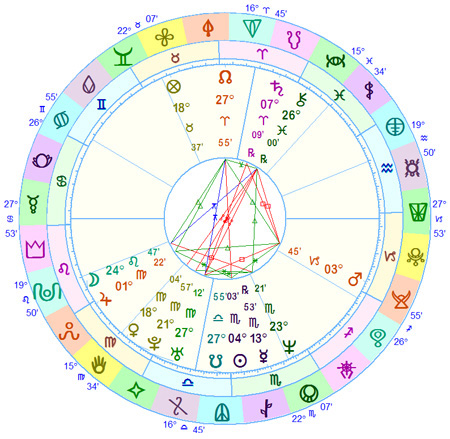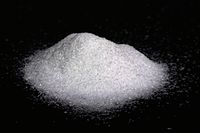 | 1. Ashvini: This symbol mimics the traditional sign for Ashvini, a horse's head. This Nakshatra represents the "head", or the beginning of the zodiac. This symbol also resembles the female reproductive system. Ashvini relates to all initiations and beginnings. |
 | 2. Bharani: Bharani is the Nakshatra of birth, death and transformation. It's symbol is the yoni. The triangle references the three stars which compose this asterism. These three stars, also known as "the Buckle of Isis" where perceived by ancient astrologers as portal between worlds. |
 | 3. Krittika: Krittika, "the one who cuts", is traditionally denoted by a blade or a flame. This symbol combines the two motifs, expressing this nakshatra's sharp, fiery and proactive nature. |
 | 4. Rohini: Rohini, the most materialistic nakshatra is represented by a four-petaled flower. This relates to its connection to the number four, as well as its typical emblem, the rose. Rohini relates to Taurine themes of fertility, stability, and abundance. |
 | 5. Mrigashira: This symbol emulates Mrigashira's emblamatic cup of soma (elixir). It also combines the symbols for Taurus and Gemini, the two zodiac signs which correspond to this nakshatra. The curved line which reflects the horns of Taurus may also be interpreted as symbolic of Mrigashira's other motif, the deer. |
 | 6. Ardra: This symbol combines this nakshatra's two emblems; the diamond and the raindrop (or teardrop). Together, they provide a visual description of Ardra's theme of growth and renewal through chaos and turbulence. |
 | 7. Punarvasu: Punarvasu means, "becoming good again". Its symbol relates to themes of retrieving, recovering, and recycling. This nakshatra is traditionally denoted by a quiver of arrows (magical weapons which return after fulfilling their mission). These arrows are depicted here in their circular path from beginning to return. |
 | 8. Pushya:Pushya is the nakshatra of nourishment, generosity and kindness. Its symbol is a circle which can be seen as a wheel, a drop of milk, a coconut, or the Moon inside a blossoming lotus flower. |
 | 9. Ashlesha: Ashlesha means "coiling" or "embracing". Its symbol is two serpentine lines symmetrically entwining, recalling Mercury's healing staff as well as the double-helix pattern of DNA molecule. This powerful nakshatra gives intuition and transformative potential. |
 | 10. Magha: Magha coincides with the beginning of Leo and epitomizes the Leonine themes of honor, pride, magnificence, duty, glory, and respect. It is symbolized here by a simple three-pointed crown. |
 | 11. Purvaphalguni: Purvaphalguni is the nakshatra of comfort, pleasure, delight, and indulgence. It follows Magha, signifying a period of relaxation following worldly accomplishment. Its symbol can be seen as one reclining in a luxurious bed. |
 | 12. Uttaraphalguni: Uttaraphalguni also represents comfort but with an emphasis on wisdom rather then sensuality. It falls into the latter part of Leo, its symbol relates to that sign. The circle representing the individual, formerly seen enveloped in the blanket of luxury, here rises up like the Sun (Uttaraphalguni's ruling planet). |
 | 13. Hasta: Hasta is symbolized by a human hand. This nakshatra relates to all work and activities done with the hands, including all forms of craftsmanship. One traditional symbol for Hasta is the potter's wheel, shown here by an empty circle. |
 | 14. Chitra: Chitra means "sparkling" or "brilliant". It is symbolized by a jewel star. Its nature is that of an artist; imagining and designing new forms, ideas, and illusions. |
 | 15. Swati: Swati is typically symbolized by a young plant shoot blown by the wind or a sword. This symbol combines the two motifs. The curved line intersecting the straight line also represents the balancing of contrasting forces. Swati is adaptable, flexible, diplomatic, and temperate. It occurs halfway through the nakshatra cycle, and relates to all crossroads and compromises.. |
 | 16. Vishakha: The symbol of Vishakha combines its traditional symbol of the triumphal arch with its meaning, "Two-Branched". Vishakha relates to the concept of single-minded fixation on a goal, and the painful sacrifice required to meeting that goal. It is the incomplete desiring completion. |
 | 17. Anuradha: After the sacrifice of Vishakha comes Anuradha, meaning "Subsequent Success". Its symbol is a staff which may be interpreted as a magician's wand or walking stick. Philosophy, astrology, and travel relate to this nakshatra. Anuradha transforms Vishakha's narrow-sighted obsession into a broader vision of reverence and awe. |
 | 18. Jyestha: Jyestha means "the Eldest". It is usually symbolized by a round amulet or earring, denoting authority. Seniority and expertise are indicated. The three lines connecting the inner and outer circles of this symbol represent the past, the present, and the future. |
 | 19. Mula: Mula means "Root" or "Center". This Nakshatra includes the Galactic Center. Our symbol is a stylization of Mula's traditional emblem: a bundle of roots. This bundle of roots represents not only Mula's urge to seek the essential nature of all things, but also to the practice of making medicines. |
 | 20. Purvashada: This joyous and optimistic nakshatra delights in beauty. Its symbol resembles the seashell upon which Venus emerges from the waters of life. It also resembles Purvashada's emblem, the fan. The fan has multiple implications. It can be used to fan a fire (to keep passion alive), to cool off (to survive adversity), as a decorative item (to enjoy art), or to hide one's face (to retain mystery). |
 | 21. Uttarashada:Uttarashada, "the Latter Invincible One" exemplifies truth, willpower, firmness, and virtue. Its symbol combines a pyramid (representing the crystallization of power), two elephant tusks (referring to Ganesha, Remover of Obstacles, its ruling deity), and the rising Sun (its ruling planet).. |
 | 22. Shravana: Shravana means "hearing" and is ruled by the Moon. It relates to listening to others well as to one's inner voice. This Lunar receptivity is symbolized by a Full Moon supported by a Crescent Moon. The three smaller circles denote the "three uneven footsteps" associated with Shravana. The lines which connect the smaller circles to the larger one evoke the connection between speakers and listeners. |
 | 23. Dhanishta: Dhanishta is represented by a drum. This bold and confident nakshatra relates to music and dance, as well as to the larger rhythms of life. The shape of this symbol reflects the rhomboid pattern of the stars of this asterism. It is divided into eight triangles, representing the Eight Vasus (demigods) who preside over Dhanishta. |
 | 24. Shatabisha: Shatabisha, "the Hundred Healers", is typically denoted by an empty circle. Emanating from the circle are four lightning-bolts, signifying the subtle electrical force present in all things. There are also smaller circles portraying electrons circumnavigating an atomic nucleus. This symbol also resembles a turtle, the carrier of the world, relating to the transpersonal nature of this often eccentric, reclusive, scientific, and mystical nakshatra. |
 | 25. Purvabhadrapada: This nakshatra is traditionally represented by a man with two faces, symbolizing the moment of death, when one exists both in this world and the next. It is also often denoted by a sword, representing severance. This symbol combines these two motifs. |
 | 26. Uttarabhadrapada: Uttarabhadrapada relates to another aspect of death, in which consciousness sinks deep into the abyss. This nakshatra is associated with the deep unconscious and the life force residing within. Its deity is Ahir Budhanya, "the Serpent of the Depths", depicted here as a serpentine line ascending a vertical axis. |
 | 27. Revati: Revati means "Wealthy" or "To Transcend". As the final nakshatra, it synthesizes and absorbs the mysteries of the previous 26. This knowledge is portrayed here by an all seeing eye. This symbol also contains two fish, representing the sign of Pisces and the soul's journey after death. |



.jpg)































